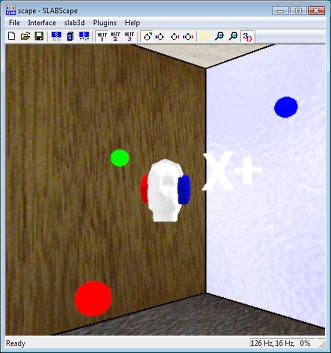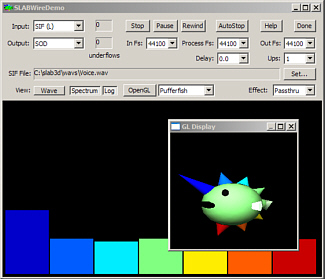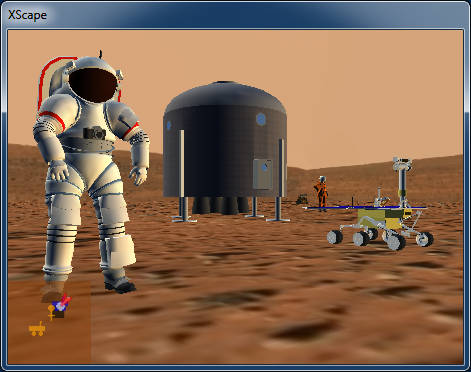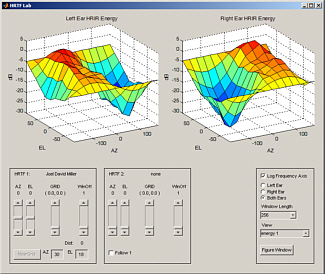slab3d release contents
Applications
- XScape renders an audio-visual
virtual environment with an emphasis on visual content. Spatial
sound processing is performed by the slab3d assembly. Graphics
processing is performed by the slabx assembly.
- SLABScape renders an audio-visual virtual
environment. Several scene parameters can be manipulated in
real-time. Spatial sound processing is performed using the SRAPI
library.
- HeadMatch is a listening
utility for comparing
HRTF databases.
- AvADE (Aviation Auditory Display
Engine) allows a Windows PC to be dedicated as an auditory server
with sounds and actions triggered via UDP or TCP/IP command strings.
The AvADE Client app serves as an example client and supports
scripting for tests and demos.
- SLABWireDemo demonstrates the features of
the slabwire library. It includes wave, spectrum, and spectrally-triggered
OpenGL displays.
- SLABSound provides ASIO, DirectSound, Waveform
API, and Wave (RIFF) file information.
- slabcon is a
Microsoft Visual Studio console application demonstrating SRAPI-based development.
- mcon is a C# version of slabcon
demonstrating the managed use of SRAPI.
- and other assorted demo and test applications...
Libraries
-
SRAPI (SLAB Render API) renders an auditory
display and/or virtual acoustic environment
(VAE). Using SRAPI, the user can allocate sound sources, define an
acoustic scene, select sound output destinations, configure
frame-accurate callbacks, automatically modify scene parameters, load
scripts and macros, and control rendering. SRAPI is also the
interface between user applications and Render Plugins (see below).
-
slabwire is used to configure a StreamIn-DSP-StreamOut processing chain. It is
used internally by SRAPI but it can also be used as a stand-alone library.
- slab3d and
slabsharp provide a managed
interface to SRAPI.
- slabx provides a set of
XNA-based classes for constructing virtual environments.
- traklib provides a high-level interface for the Polhemus Fastrak electromagnetic
tracker.
Render Plugins
encapsulate the VAE
rendering engine and auditory display processing. Plugins can be swapped in and out while
rendering allowing for the comparison of different rendering
strategies. Plugins also allow for the construction of tailored
displays for specific applications (e.g., a spatial communications system).
- Spatial renders a virtual acoustic
scene. Most SRAPI functions are designed for use with Spatial.
See specs below.
- Spatial2 extends Spatial
with level meters, instant replay, and silence-skip catch-up.
- Mixer mixes each sound
source into 32 possible sound outputs including two spatial aux
sends per source. See the Mixer block diagram in the slab3d
User Manual, the SRAPI SrcMix functions, and the SLABScape Mixer
Settings dialog.
- Left-Monotic,
Right-Montic, Diotic, and Dichotic
render trivial displays for spatial/non-spatial A/B comparison.
Generator Plugins provide the signal generator
sound sources available to SRAPI and slabwire. The plugin format
allows users to add additional signal
generation algorithms without modifying slab3d itself.
slab3d
includes two Generator Plugins:
- gslab contains sine, square,
noise, noisepulse, triangle, amplitude modulation, and impulse signal generators.
- gstk contains all of the
STK
v4.5.1 instruments.
|

 |
| System |
| Operating Systems |
Windows 2000/XP/Vista/7/8/10 |
|
Sample Inputs |
- Waveform-Audio device
- ASIO device
- direct-from-disk file (8,16-bit PCM)
- memory-buffered file (8,16-bit PCM)
- recorded input (track recorder)
- real-time user samples
- Voice-over-IP (VoIP)
- DIS frequency
- DIS radio
- HTTP URL-specified internet file (8,16-bit PCM,
32-bit float)
- source submix
- signal generator plugins
- channel link
|
|
Sample Outputs |
- Waveform-Audio
device
- ASIO device
- DirectSound device
- direct-to-disk file
- memory-buffered file
- splitter
|
| Sample Rates |
Sample Input: arbitrary, resampled to engine rate
as needed
Engine (processing and output): arbitrary
Spatial Renderer (HRTF and material filters): 8000, 8192, 11025, 22050, 44100, 48000
Hz |
| API Latency |
4.3ms (ASIO buffer size = 64 samples, fs
= 44.1kHz),
23ms (DirectSound buffer size = 1024 stereo samples, fs = 44.1kHz) |
| Full-Duplex Latency |
6.1ms (ASIO buffer size = 64 samples, fs
= 44.1kHz) |
| Delay Lines |
2x upsampled (optional) with linearly interpolated
extraction |
| Frame Size |
32 samples |
| Acoustic Scene |
| Number of Sound Sources |
arbitrary, limited by CPU resources, 256
max |
| Number of Listeners |
1 |
| Room |
rectangular room, image model, 6
first-order reflections |
| Environment Modeling |
sound source location (x,y,z), wall
location (length, width, depth), listener position (x,y,z,pitch,roll,yaw),
head tracker sensor location (x,y,z); Render Plugin parameters for sound propagation delay, spherical spreading loss,
wall materials, head and pinna (HRTF database HRIR and ITD interpolation) |
| Scene Update Rate |
arbitrary, 120 Hz typical |
| Numerical Precision |
double-precision floating-point scene
geometry calculations |
| Spatial Render Plugin |
| Environment Modeling |
sound propagation delay, spherical
spreading loss, wall materials, head and pinna (HRIR and ITD) |
| DSP Update Rate |
delay line indexing = every sample
(22.7us), FIR taps = every 64 samples (1.45ms), leaky integrator parameter
tracking |
| HRIR FIR Taps |
variable, typical: direct sound path =
128 taps, reflections = 32 taps |
| Wall Materials Filter |
first-order IIR filter |
| Numerical Precision |
single-precision floating-point signal
processing calculations |





